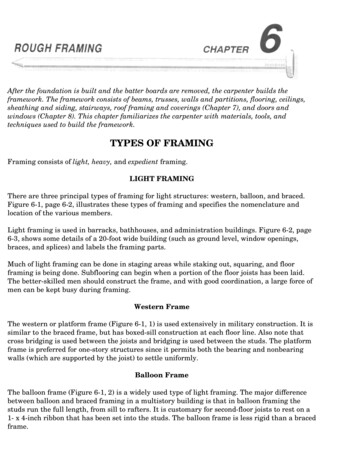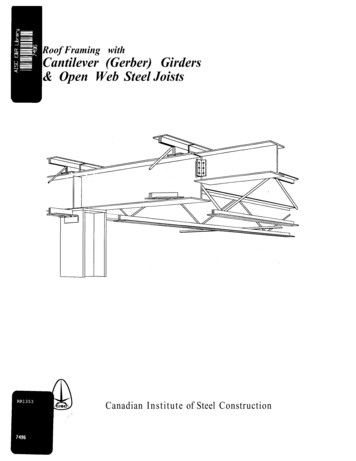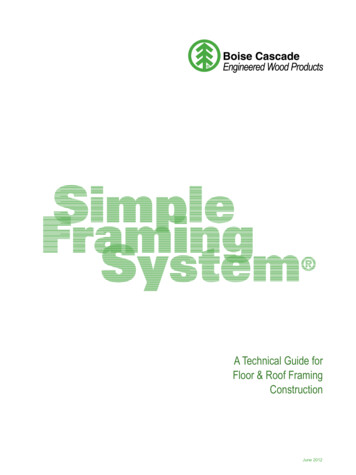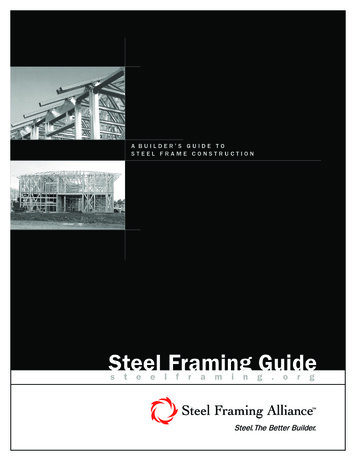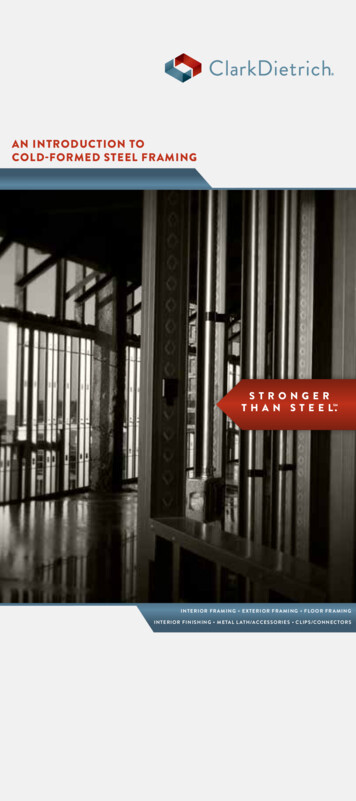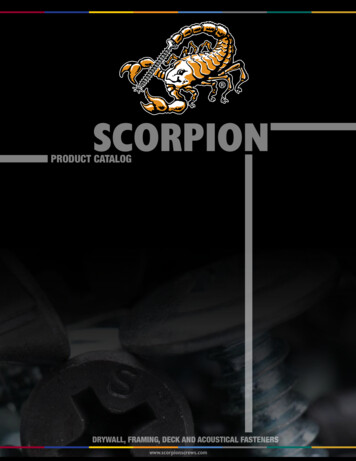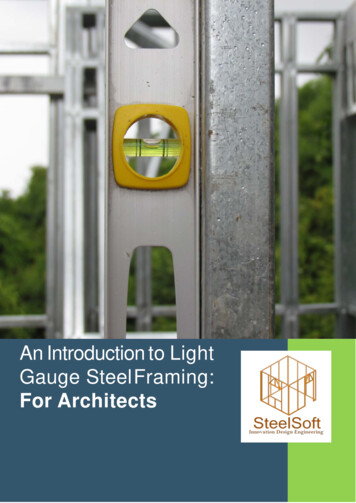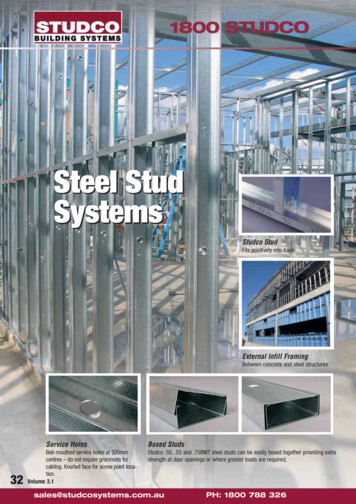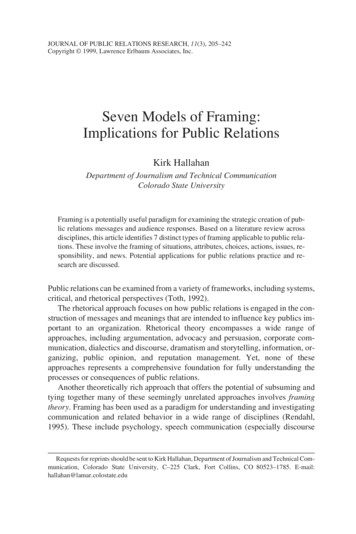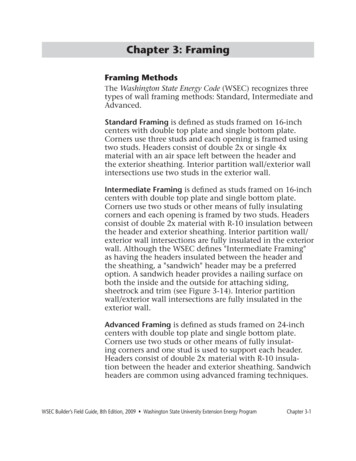
Transcription
Chapter 3: FramingFraming MethodsThe Washington State Energy Code (WSEC) recognizes threetypes of wall framing methods: Standard, Intermediate andAdvanced.Standard Framing is defined as studs framed on 16-inchcenters with double top plate and single bottom plate.Corners use three studs and each opening is framed usingtwo studs. Headers consist of double 2x or single 4xmaterial with an air space left between the header andthe exterior sheathing. Interior partition wall/exterior wallintersections use two studs in the exterior wall.Intermediate Framing is defined as studs framed on 16-inchcenters with double top plate and single bottom plate.Corners use two studs or other means of fully insulatingcorners and each opening is framed by two studs. Headersconsist of double 2x material with R-10 insulation betweenthe header and exterior sheathing. Interior partition wall/exterior wall intersections are fully insulated in the exteriorwall. Although the WSEC defines "Intermediate Framing"as having the headers insulated between the header andthe sheathing, a "sandwich" header may be a preferredoption. A sandwich header provides a nailing surface onboth the inside and the outside for attaching siding,sheetrock and trim (see Figure 3-14). Interior partitionwall/exterior wall intersections are fully insulated in theexterior wall.Advanced Framing is defined as studs framed on 24-inchcenters with double top plate and single bottom plate.Corners use two studs or other means of fully insulating corners and one stud is used to support each header.Headers consist of double 2x material with R-10 insulation between the header and exterior sheathing. Sandwichheaders are common using advanced framing techniques.WSEC Builder’s Field Guide, 8th Edition, 2009 Washington State University Extension Energy ProgramChapter 3-1
Intermediate Framing Materials. Most prescriptive optionsrequire intermediate wall framing. Credit for the addedthermal efficiency gained by advanced framing is alsoallowed if a project follows the component performanceor systems analysis approach. To meet the requirements ofintermediate wall framing, installation of foam insulationfor headers is required (see Figure 3-14).Advanced Framing Materials. If you’re planning to doadvanced wall framing, be sure to order sheathing, siding,and wallboard rated for a 24-inch on-center framing.The WSEC does not require advanced framing for walls,but will credit the added thermal efficiency gained byadvanced framing if your project follows a componentperformance or systems analysis approach (see pages 1-7and 1-11).Advanced Framed Ceilings. The WSEC requires “advanced”roof/ceiling framing for some prescriptive paths and willcredit the added thermal efficiency gained by advancedframing if your project follows the component performance or systems analysis approach. Advanced framing isdefined as having full and even depth insulation extendingto the outside edge of exterior walls. This may be accomplished by using a raised heel truss, using an oversizedtruss or using a high R-value foam product at the wall line(see figure 3-15).Windows. Before you order or install windows, make surethe windows meet Code requirements (see Chapter 1).Heat loss through windows, per square foot, is very highcompared to most other building envelope components.Decisions about window type, glazing area, and orientation can be the most important energy performancechoices you make for the home.U-Factors are a measure of window energy performance.The lower the U-factor, the lower the rate of heat transfer, and the better the energy performance of the window.The total window area and the area weighted U-factor(see page 1-4) for all windows must meet the compliancepath chosen. Always check with your building jurisdictionbefore adding additional windows or changing windowChapter 3-2WSEC Builder’s Field Guide, 8th Edition, 2009 Washington State University Extension Energy Program
type. Unapproved changes may result in unnecessary construction delays while compliance is reverified.All windows and skylights should be tested to establishU-factors. Only National Fenestration Rating Council(NFRC) Standard 100-2004 test results from a certified laboratory will be acceptable. NFRC Residential Model Sizemust be used. If a test result is not available, you mustuse the appropriate default U-factor listed in the Code forCompliance (see WSEC Table 10-6A and Table 10-6B).Solar heat gain coefficient (SHGC) will also be needed if aSystems Analysis Approach is being utilized.For more information on NFRC labeling, visit the EfficientWindows Collaborative web site:www.efficientwindows.org/nfrc.htmlNote: The Code considers a sliding glass door a window.Some windows may require special jamb extensionsbecause of added wall thickness needed to accommodaterequired insulation levels.Exterior Doors. The following doors must meet the chosencompliance path required U-factor for exterior doors: [502.1.5.2,Exception 3]Entry doors.Garage passage doors.Interior doors to unheated basements.Doors joining any heated space with an unheatedspace. One swinging door of not more than 24 squarefeet may be exempted from the door U-factorrequirement.WSEC Builder’s Field Guide, 8th Edition, 2009 Washington State University Extension Energy ProgramChapter 3-3
Figure 3-1Standard, Intermediate, and Advanced FramingChapter 3-4WSEC Builder’s Field Guide, 8th Edition, 2009 Washington State University Extension Energy Program
If a tested value for the door assembly you plan to useis not available, then use the default values in WSECTable 10-6C.Note: The area of glazing that is part of any swinging door is included in thetotal glazing area of the house as determined for prescriptive compliance. TheU-factor of this door glazing, however, is counted as part of the doors overallU-factor (see WSEC Table 10-6C).Skylights. Skylights are included in the total glazingpercentage for the home. Skylights must meet U-factor requirements specific to overhead glazing. DefaultU-factors for overhead glazing are listed in WSECTable 10-6E.Energy-Efficient Floor FramingFramed floors over unconditioned space must be able toaccommodate the levels of insulation required (see Chapter4 for insulation details).[502.4.3]Sealing Air Leaks. The WSEC requires that all openings,joints, and penetrations in the thermal envelope of thebuilding must be sealed, caulked, gasketed or weatherstripped to limit air leakage.The first floor rim joist area over a basement and the rimjoist area between floors may require special attentionduring framing (see Figures 3-2, 3-3 and Chapter 5, AirLeakage and Moisture Control).[502.1.6.2]Vapor Retarders. Floors over unconditioned space mustinclude a vapor retarder. Manufactured flooring materials(plywood, etc.) with exterior grade glues meet this requirement. Flooring systems such as 2x6 decking that do notinclude plywood or similar materials must use kraft paper,poly sheathing or some other rated material as a vaporretarder (see Figure 3-4).WSEC Builder’s Field Guide, 8th Edition, 2009 Washington State University Extension Energy ProgramChapter 3-5
Figure 3-2Basement Rim Air Barrier[502.4.3]Chapter 3-6WSEC Builder’s Field Guide, 8th Edition, 2009 Washington State University Extension Energy Program
Figure 3-3Standard Rim Air Barrier[502.4.3]WSEC Builder’s Field Guide, 8th Edition, 2009 Washington State University Extension Energy ProgramChapter 3-7
Figure 3-4Post and Beam Air SealingChapter 3-8WSEC Builder’s Field Guide, 8th Edition, 2009 Washington State University Extension Energy Program
Energy-Efficient Wall FramingYou may use any wall detail that has an insulation nominalR-value equal to or exceeding your chosen compliance path(see Figure 3-5 and Chapter 1).[602.2]Wall Details. The Prescriptive Approach identifies four alternativesas equivalent to the nominal R-21 wall (see Figures 3-5 and 3-6).In addition, the Component Performance and Systems AnalysisApproaches credit the use of higher R-value walls (see Figure 3-7).The use of double framed walls or stressed-skin panels are amongother options that may work (see Figure 3-8).Insulated Sheathing. Insulated sheathing may be used toincrease the R-value of a wall. Insulated sheathing can beused to meet the requirements in Prescriptive Paths II andIII in Table 6-2. If the insulated sheathing is used in place ofstructural sheathing, additional wall bracing will be required.Consult the International Residential Code (IRC) for bracingrequirements in your area.Rigid foam insulation may be applied to either the interior orexterior surface of the exterior wall (see Figures 3-9, 3-10 and3-11). Applying foam to the exterior is the preferred option.Additional references, prepared by the APA Engineered WoodAssociation, may also be useful. Check the various resourcesavailable on the APA website: www.apawood.orgInsulation. The Code requires all cavities in the thermal envelope of the building be filled with insulation. Corners andwall intersection can easily be filled during the normal placement of wall insulation using certain details (see Figures 3-12and 3-13).Headers. Headers must always be properly sized to meetloading conditions. All Prescriptive Path Options in ClimateZone 1 and Prescriptive Path Option 1 in Climate Zone 2require Intermediate framed walls. Intermediate wall framingrequires R-10 insulated headers unless structural requirements specify a 6x header.WSEC Builder’s Field Guide, 8th Edition, 2009 Washington State University Extension Energy ProgramChapter 3-9
Figure 3-5Acceptable R-21 WallsChapter 3-10WSEC Builder’s Field Guide, 8th Edition, 2009 Washington State University Extension Energy Program
Figure 3-6Acceptable Prescriptive Substitutes for R-21 WallsWSEC Builder’s Field Guide, 8th Edition, 2009 Washington State University Extension Energy ProgramChapter 3-11
Figure 3-7R-24 & Above WallsChapter 3-12WSEC Builder’s Field Guide, 8th Edition, 2009 Washington State University Extension Energy Program
Figure 3-8Double WallWSEC Builder’s Field Guide, 8th Edition, 2009 Washington State University Extension Energy ProgramChapter 3-13
Figure 3-9Above-Grade Wall:Interior Rigid InsulationChapter 3-14WSEC Builder’s Field Guide, 8th Edition, 2009 Washington State University Extension Energy Program
Figure 3-10Interior Rigid Foam Framing DetailsWSEC Builder’s Field Guide, 8th Edition, 2009 Washington State University Extension Energy ProgramChapter 3-15
Figure 3-11aCorner Trim Detail for Exterior Rigid InsulationFigure 3-11bDoor Reinforcementfor Exterior Rigid InsulationChapter 3-16WSEC Builder’s Field Guide, 8th Edition, 2009 Washington State University Extension Energy Program
Figure 3-12Optional Details Allowing Easy Placement of Insulation - 1WSEC Builder’s Field Guide, 8th Edition, 2009 Washington State University Extension Energy ProgramChapter 3-17
Figure 3-13Optional Details Allowing Easy Placement of Insulation - 2Chapter 3-18WSEC Builder’s Field Guide, 8th Edition, 2009 Washington State University Extension Energy Program
Figure 3-14Header Details(Required for Intermediate and Advanced Framing)WSEC Builder’s Field Guide, 8th Edition, 2009 Washington State University Extension Energy ProgramChapter 3-19
Energy-Efficient Ceiling/Roof FramingAdvanced Framing. An oversized or raised heel trussreplaces the standard truss to avoid compressing insulationat the exterior wall (see Figure 3-15).Figure 3-15Options to Maintain Full Heel Insulation(Advanced Frame Ceiling)Chapter 3-20WSEC Builder’s Field Guide, 8th Edition, 2009 Washington State University Extension Energy Program
[502.1.4.3,502.1.4.5]Attic Venting. Venting must meet IRC requirements. Whenventing is placed at the eaves, special consideration mustbe given to baffling the insulation in order to maintain aminimum 1 inch of free area for air movement from thevent into the attic (see Figure 4-4).Exception for Attic VentingThe WSEC allows an unvented attic under certain conditions. Unvented attics are created when a spray foam insulation product is applied directly to the underside of theroof sheathing or when rigid board insulation is installeddirectly over the structural roof sheathing. It is critical thatCode requirements are met to avoid potential moistureproblems, including: The unvented attic space is completely containedwithin the building thermal envelope. No interior vapor retarders are installed on theceiling side (attic floor) of the unvented atticassembly. Where wood shingles or shakes are used, a minimum1/4-inch (6 mm) vented air space separates theshingles or shakes and the roofing underlaymentabove the structural sheathing. Any air-impermeable insulation shall be a vaporretarder, or shall have a vapor retarder coating orcovering in direct contact with the underside of theinsulation, unless regid insulation board is installover the structural roof sheathing.There are three methods for constructing unvented atticspaces. With all three methods, it is important to checkthat the insulation’s listing allows it to be installed to theprescriptive required R-value. If not, a Component Performance or Systems Analysis Approach must be used. Alsocheck the listing to see if a fire retardant material needs tobe applied to the exposed insulation. Figure 3-16 shows theinstallation of air-impermeable insulation installed directlyto the underside of the roof deck. This typically requires aclosed cell product.WSEC Builder’s Field Guide, 8th Edition, 2009 Washington State University Extension Energy ProgramChapter 3-21
Figure 3-16Air-Impermeable Insulation Only,In Direct Contact with Roof SheathingThe second method shown in Figure 3-17 is used whenapplying an air-permeable product directly to the underside of the roof decking. This method requires rigidboard or sheet insulation on the top of the roof deck.The required R-values of the rigid insulation are R-10 inClimate Zone 1 and R-25 in Climate Zone 2.The third method is used when combining air-impermeable and air-permeable insulation (see Figure 3-18). This issometimes referred to as a “hybrid” system. Air-impermeable insulation is applied directly to the underside of theroof deck. As with the previous method, the air-impermeable insulation must be installed to a minimum of R-10 inClimate Zone 1 and R-25 in Climate Zone 2. Air-permeableinsulation may now be installed to reach required R-values.Chapter 3-22WSEC Builder’s Field Guide, 8th Edition, 2009 Washington State University Extension Energy Program
Figure 3-17Air-Impermeable and Air Permeable Insulation InteriorFigure 3-18Air-Permeable Insulation Interior, Air Impermeable ExteriorWSEC Builder’s Field Guide, 8th Edition, 2009 Washington State University Extension Energy ProgramChapter 3-23
Vaulted Ceilings*. Following some prescriptive paths,single rafter vaults require R-38 insulation. Componentperformance compliance may allow less than R-38 ifanother component makes up the difference (see Chapter5). Various options for framing vaulted ceilings to obtainhigh levels of insulation are available (see Figure 3-19).* A vaulted ceiling is defined as a ceiling where enclosed joist or rafter space is formed byceilings applied directly to the underside of roof joists or rafters. A sloped ceiling of ascissor truss is not considered a vaulted ceiling.[502.1.6.3]Vault Cavity Ventilation. Most ceilings with insulationbeneath the structural sheathing, including vaults, mustprovide a minimum 1-inch air space above the insulation(see Figure 3-20).Chapter 3-24WSEC Builder’s Field Guide, 8th Edition, 2009 Washington State University Extension Energy Program
Figure 3-19Vaulted CeilingsWSEC Builder’s Field Guide, 8th Edition, 2009 Washington State University Extension Energy ProgramChapter 3-25
Figure 3-20Venting Vaulted CeilingsChapter 3-26WSEC Builder’s Field Guide, 8th Edition, 2009 Washington State University Extension Energy Program
WSEC Builder’s Field Guide, 8th Edition, 2009 Washington State University Extension Energy Program Chapter 3-21 [502.1.4.3, 502.1.4.5] Attic Venting. Venting must meet IRC requirements. When venting is placed at the eaves, special consideration must b
